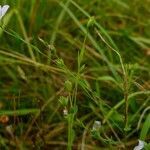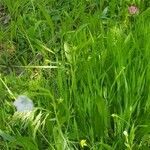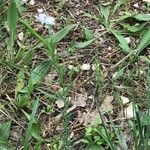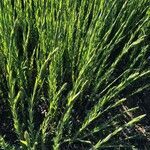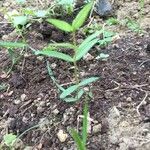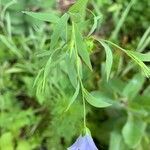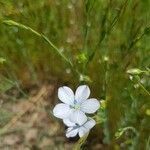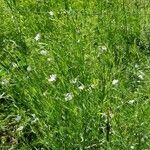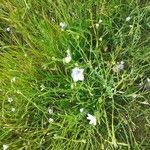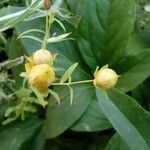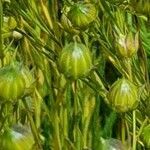Herbs, annual, 20–100 cm, glabrous or glabrate throughout. Stems erect, unbranched or few-branched at base (all flowering). Leaves divergent; blade linear to linear-lanceolate, 10–40 × 1.5–5 mm. Inflorescences open panicles. Pedicels erect in fruit, to 20–25 mm. Flowers homostylous; sepals ovate, 6–9 mm, margins of inner sepals minutely ciliate, outer ciliate, apex acuminate; petals usually blue, rarely white, obovate, 10–15 mm; stamens 5–7 mm; anthers 1–1.5 mm; staminodia present; styles distinct or connate at base, 3–6 mm; stigmas linear or clavate. Capsules ovoid to subglobose, 6–10 × 5–10 mm, apex rounded, dehiscing incompletely, segments falling freely, margins ciliate or not. Seeds 4–6 × 2.5–3 mm. 2n = 30.
Annuals 30-120 cm tall. Stems simple, cylindric, erect, woody at base, apically corymbosely branched. Leaves alternate, linear, linear-lanceolate, or lanceolate, 2-4 cm × 1-5 mm, 3(or 5)-veined from base, base attenuate, apex acute. Flowers axillary, solitary or in broad cymes, 15-20 mm in diam. Pedicel 1-3 cm, erect. Sepals ovate to ovate-lanceolate, 5-8 mm, 3(or 5)-veined from base, nonglandular, margin entire or ciliate, apex acute to acuminate. Petals blue, rarely white or red, obovate, 0.8-1.2 cm. Styles distinct; stigma linear-clavate. Capsule globose, 6-9 mm in diam., septicidal, with 10 seeds. Seeds brown, oblong, flattened, 3.5-4 mm. Fl. Jun-Aug, fr. Jul-Oct. 2n = 30.
Annual herb, sometimes woody at base, up to 60–65 cm. high.. Stem terete, faintly longitudinally ridged.. Leaves sessile, alternate, linear-lanceolate, 30–60 mm. long, glabrous.. Inflorescence a corymbose cyme; pedicels 20–30 mm. long.. Sepals 5, ovate-acuminate, about 5 × 2.5 mm. in flower, enlarging to about 7×4 mm. in fruit, with papery translucent entire margin; main vein prominent only in basal half of sepal.. Petals 5, free, obovate, 8 × 3.5 mm., narrowing to a clawed base, blue or white.. Stamens 5.. Ovary 5-locular.. Capsule 10-valved, globose, 8–10 mm. in diameter, exceeding calyx in length, honey-brown.. Seeds shining, light brown, ± 5 mm. long.
Annual; stems 1–several, erect, to 1 m; lvs lance-linear, 3-nerved, 1.5–3.5 cm; sep 7–9 at maturity, the inner minutely ciliate on the scarious margin; pet blue, 10–15 mm; staminodes minute, tooth-like; stigmas linear-clavate; fr 6–10 mm, subglobose and abruptly short-beaked, tending to be only tardily and incompletely dehiscent, the mericarps acuminate; false septa very incomplete, long-ciliate; 2n=30. European cultigen, often escaped or adventive in fields and roadsides in U.S. and s. Can. Summer. (L. humile)
Glabrous annual; stems erect, unbranched to 1 m long. Leaves alternate, linear to narrowly elliptic, 7–20 mm long, acute. Inflorescences loose cymose panicles; pedicels 14–50 mm long. Sepals ovate, 7–9 mm long, acuminate, margins membranous, sometimes ciliolate. Petals obovate, 11–13 mm long, blue, rarely white. Anthers white. Styles connate only at base. Capsule 6–10 mm diam. Seeds 4–5 mm long, grey–brown.
An annual herb. It has a single stem 70-100 cm high. It branches only in the upper part when flowering. Varieties for flax are single stemmed while varieties for linseed seed are more branched. The leaves are small and hairless. The flowers are blue or white. The petals are 13-18 mm long. The capsule is 6-9 mm wide. It contains 10 seeds. These are flat and oblong.
